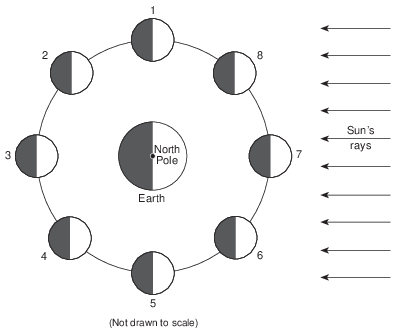Topic: Equilibrium And Stability
Equilibrium And Stability
Which graph best shows the general relationship between a planet’s distance from the Sun and the Sun’s gravitational attraction to the planet?

(1) 1
(2) 2
(3) 3
(4) 4

Since Earth has an elliptical orbit, the
(1) distance between the Sun and Earth varies
(2) distance between the Sun and the other focus varies
(3) length of Earth’s major axis varies
(4) length of Earth’s period of revolution varies
The gravitational attraction between two objects in the solar system is greatest when their masses are
(1) small, and the objects are close together
(2) small, and the objects are far apart
(3) large, and the objects are far apart
(4) large, and the objects are close together
The diagram below represents planets A and B, of equal mass, revolving around a star.

Compared to planet A, planet B has a
(1) weaker gravitational attraction to the star and a shorter period of revolution
(2) weaker gravitational attraction to the star and a longer period of revolution
(3) stronger gravitational attraction to the star and a shorter period of revolution
(4) stronger gravitational attraction to the star and a longer period of revolution

Identify which point, X or Y, has more stream erosion and explain why the amounts of erosion are different. [1]
Point:
Explanation:
Allow 1 credit for X and a correct explanation. Acceptable explanations include, but are not limited to:
• — Point X is on the outside of a meander curve.
• — Stream velocity is greater at point X.
• — More deposition occurs at Y.

On which date shown in the data table was the gravitational attraction between the Moon and Earth the greatest? [1]
December _________, 2010
Allow 1 credit for December 24, 2010.

Explain why the distance, d, from the water table to the land surface would decrease after several days of heavy rainfall. [1]
Allow 1 credit. Acceptable responses include, but are not limited to:
• — The heavy rainfall will infiltrate the ground, causing the water table to rise closer to the
• surface.
• — Infiltration will occur.
• — The ground becomes more saturated.
• — The saturated zone will increase.
• — The water table will rise.
• — erosion of the land surface
• Note: Do not allow credit for the process of weathering acting alone.

Explain why the Moon’s orbital velocity is slowest when the Moon is farthest from Earth. [1]
Allow 1 credit. Acceptable responses include, but are not limited to:
• — The gravitational attraction between the Moon and Earth is least when they are farthest
• apart.
• — The force of gravity is less.
• — Gravitational attraction is greater when the Moon is closer to Earth.

Explain why the Moon’s revolution and rotation cause the same side of the Moon to always face Earth. [1]
Allow 1 credit. Acceptable responses include, but are not limited to:
• — The Moon’s period of rotation equals the Moon’s period of revolution.
• — The Moon rotates at the same rate that it revolves around Earth.
• — The Moon spins once during each revolution.
• — Both motions are completed in 27.3 days.

Identify the letter of the exoplanet with the shortest period of revolution and explain why that exoplanet has the shortest period of revolution. [1]
Exoplanet: Explanation:
Allow 1 credit for exoplanet b with an acceptable explanation. Acceptable explanations include, but are not limited to:
• — The planet closest to the star moves fastest due to greatest gravitational force.
• — It is closest and has the least distance to travel in its orbit.
• — The planet with the shortest period of revolution is always the planet that is nearest to the
• star.
• — The closer to the star, the faster an exoplanet orbits.
• — closest to the star/Sun
• — Exoplanet b has the smallest/shortest orbit.

State the names of two different metamorphic rocks that are most likely found in the zone of contact metamorphism at locations X and Y. [1]
Location X: Location Y:
Allow 1 credit if both responses are correct. Acceptable responses include:
• Location X:
• — marble
• — hornfels
• Location Y:
• — quartzite
• — hornfels
• Note: Do not allow credit if hornfels is used for both locations X and Y.

Explain why the surface of Lake Erie freezes much later in the winter than the surrounding land surfaces. [1]
Allow 1 credit. Acceptable responses include, but are not limited to:
• — Water has a higher specific heat than land.
• — Water takes a longer time to cool than land.
• — Land surfaces cool faster.
